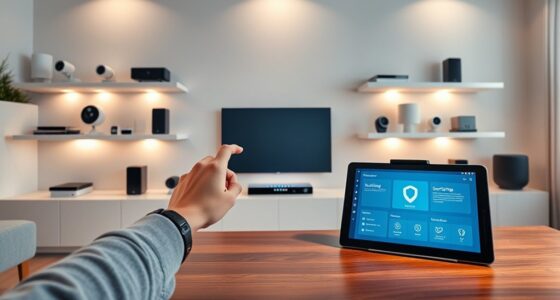The future of smart homes will see seamless AI integration, predictive automation, and ultra-fast connectivity via Wi-Fi 6E and 5G. Devices will communicate instantly, personalize environments, and proactively address issues while keeping your privacy secure. Security features like biometrics and encryption will protect your data, and immersive technologies will boost virtual interactions. Sustainability and robotics will simplify household tasks and care, creating smarter, safer, and more personalized living spaces. Stay tuned to learn how these innovations will shape your home experiences.
Key Takeaways
- Fully integrated ecosystems with seamless AI, device interoperability, and personalized automation will offer more intuitive user experiences.
- Advanced connectivity like Wi-Fi 7, 5G, and mesh networks will enable ultra-fast, reliable, and low-latency communication among devices.
- Enhanced security protocols, biometric access, and decentralized data management will strengthen privacy and protect against cyber threats.
- Immersive technologies such as holograms, high-realism video conferencing, and multi-sensory environments will transform virtual interactions.
- Sustainable innovations, including zero-energy homes and real-time energy optimization, will make smart homes more eco-friendly and energy-efficient.
Full Integration of Artificial Intelligence and Predictive Automation

As artificial intelligence becomes more advanced, smart homes will seamlessly integrate AI and predictive automation to enhance everyday living. You’ll notice smart devices working together, analyzing your habits and preferences through machine learning. This integration not only improves convenience but also enhances cybersecurity, safeguarding your personal data and home systems from potential threats. This means your home can proactively adjust lighting, temperature, and security settings before you even ask. Predictive automation uses real-time data to detect issues like appliance malfunctions or security threats early, preventing problems from escalating. AI-driven personalization tailors environmental conditions and entertainment options to fit your lifestyle perfectly. Additionally, home automation systems will increasingly utilize advanced sensors and data analytics to anticipate needs. With full integration, your smart home becomes a cohesive system that responds contextually across devices, creating an intuitive experience. This seamless harmony makes daily routines smoother, more comfortable, and more secure, all driven by intelligent automation anticipating your needs before you even realize them.
Enhanced Connectivity for Seamless Device Interoperability
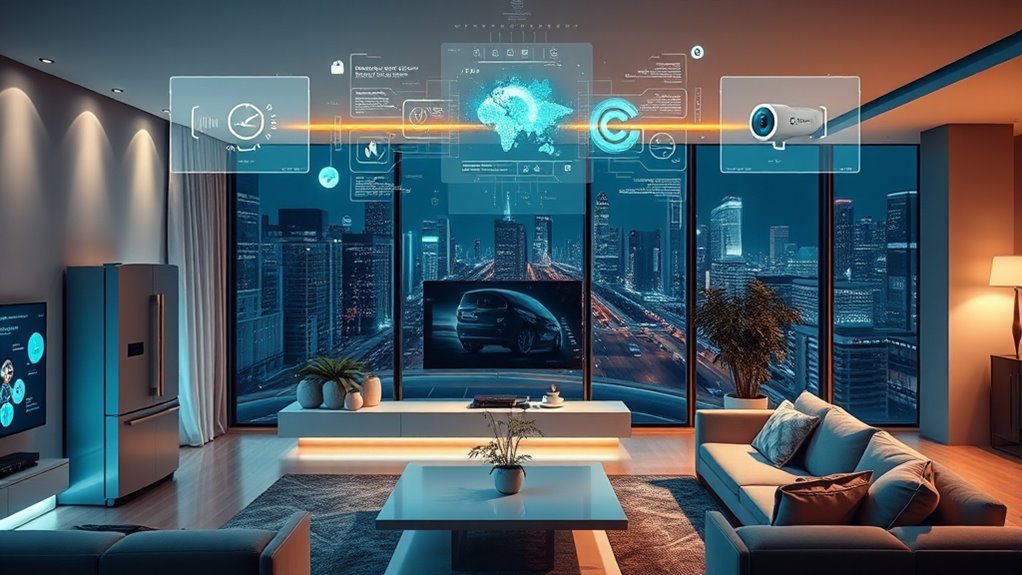
Enhanced connectivity in smart homes means your devices will communicate faster and more reliably, creating a smoother experience. With advancements like Wi-Fi 6E, 5G, and standardized protocols such as Matter, integration becomes simpler across different brands. Additionally, ongoing innovations in smart utilities ensure that your home’s energy management systems are more synchronized and efficient than ever before. These improvements also support real-time communication, enabling your devices to respond instantly to changes and commands. For example, the use of Ring Security Cameras can be optimized through these technologies, ensuring continuous and seamless surveillance. Incorporating wireless sensor networks enhances the overall responsiveness and adaptability of the smart home ecosystem. Moreover, understanding the 16PF traits can help in designing systems tailored to user preferences and behaviors, improving overall user experience. This robust network foundation guarantees your home remains responsive, no matter how many devices are connected.
Faster Internet Speeds
Faster internet speeds are transforming how smart homes operate by enabling devices to communicate almost instantaneously. With internet speeds exceeding 10 Gbps, connectivity becomes more reliable, supporting seamless interactions among smart devices. This Enhanced connectivity allows for more complex automation routines and better integration of new devices into existing systems. Additionally, the development of essential oil technology in smart home devices can facilitate mood enhancement and health monitoring, further enriching user experience. This high-speed network reduces latency, allowing AI-driven automation and security systems to respond in real-time. You’ll experience smooth high-definition video streaming and immersive augmented reality features without buffering or delays. These advancements mean multiple smart devices can run simultaneously without performance issues, creating a more integrated and efficient home environment. The development of fiber-optic and 5G technologies plays a vital role in delivering these ultra-fast, stable connections. As internet speeds continue to grow, your smart home will become increasingly responsive, intuitive, and capable of supporting a wide range of connected devices and applications. Moreover, faster speeds facilitate the integration of personal development tools and resources, such as mindfulness and goal-setting apps, enhancing overall user well-being. Furthermore, the increased bandwidth supports cloud-based management systems that enable remote monitoring and control of your smart home from anywhere in the world.
Robust Wireless Networks
Advances in wireless technology are revolutionizing smart homes by providing more reliable and seamless connectivity across all devices. Modern wireless networks, including Wi-Fi 7 and mesh systems, deliver faster data transfer rates up to 30 Gbps, supporting high-resolution streaming and real-time control.
These improvements ensure that your devices stay connected without interruptions or dead zones, even in larger homes. New protocols focus on low latency and high responsiveness, allowing voice assistants and security cameras to operate flawlessly under heavy network loads. Additionally, integrating 5G and LPWAN technologies expands connectivity options beyond traditional Wi-Fi, boosting reliability and scalability. The integration of AI Security technologies in wireless networks further enhances threat detection and ensures your smart home remains protected from cyber threats. As a result, wireless network advancements are key to enabling smarter and more interconnected living spaces. With these developments, your smart home will enjoy enhanced connectivity, making device interoperability smoother, more dependable, and ready for the future. Market growth projected at over 40% CAGR in AI tech by 2025. Furthermore, ongoing innovations in wireless standards continue to push the boundaries of what connected homes can achieve, especially as automation technology becomes more sophisticated and integrated.
Standardized Communication Protocols
As smart home devices become more widespread, the need for reliable communication between them grows more critical. Standardized communication protocols like Matter, Zigbee 3.0, and Z-Wave Plus are key to achieving interoperability and compatibility among diverse devices. Self-awareness can be enhanced through understanding these protocols and their role in creating a cohesive ecosystem. These protocols enable seamless device communication, reducing compatibility issues and making system setup easier for you. Additionally, the integration of predictive analytics into smart home systems can improve their responsiveness and personalization, adapting to your habits over time. Incorporating device security features within these standards helps safeguard your data and prevent unauthorized access across connected devices. The development of security standards is essential for maintaining trust and ensuring privacy in smart home environments. By 2025, over 70% of new smart home products are expected to support multiple protocols, creating a more flexible ecosystem. The adoption of universal standards accelerates third-party device integration, fostering a more cohesive, scalable, and reliable smart home environment that works effortlessly for you.
Advanced Security Solutions With Biometric and AI Technologies
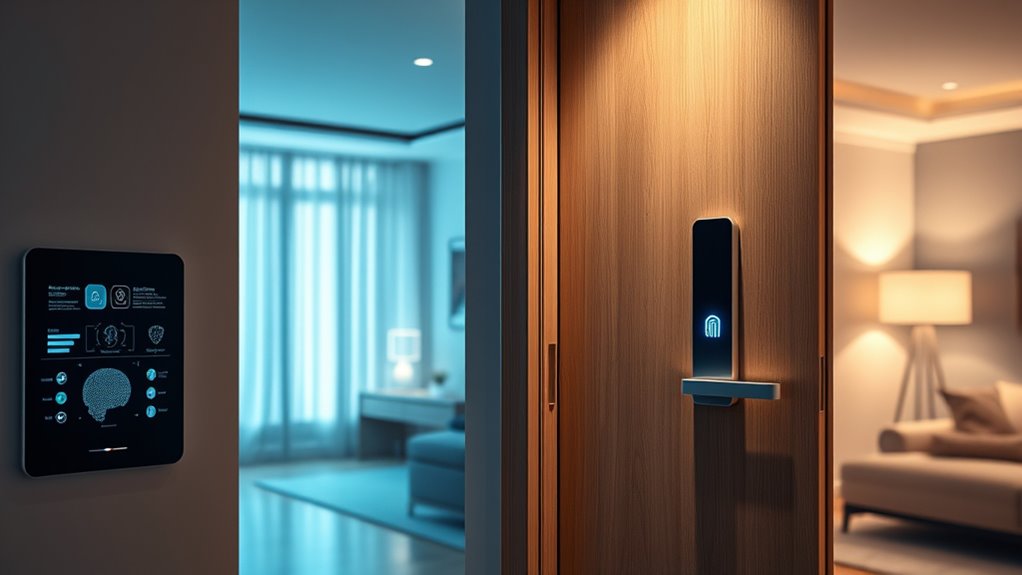
Advanced security solutions in smart homes are transforming the way residents protect their property and loved ones. Biometric security, AI-powered security, and surveillance systems work together to provide unmatched safety. Facial recognition and behavioral analysis identify people with near-perfect accuracy, while biometric access controls like fingerprint and retina scans replace traditional keys, ensuring seamless entry. Surveillance cameras analyze footage in real-time, detecting unusual activity and alerting you instantly, even in low-light conditions. Autonomous security drones can patrol continuously, offering active surveillance and rapid responses beyond static cameras. These technologies proactively detect threats and environmental hazards, enabling immediate autonomous action. Moreover, ongoing research highlights AI vulnerabilities that must be addressed to maintain trust and security in these advanced systems.
| Security Feature | Benefits |
|---|---|
| Biometric Security | Seamless, secure access |
| AI Surveillance | Real-time threat detection |
| Autonomous Drones | Continuous monitoring and response |
Immersive Audio-Video Interactivity and Virtual Communication
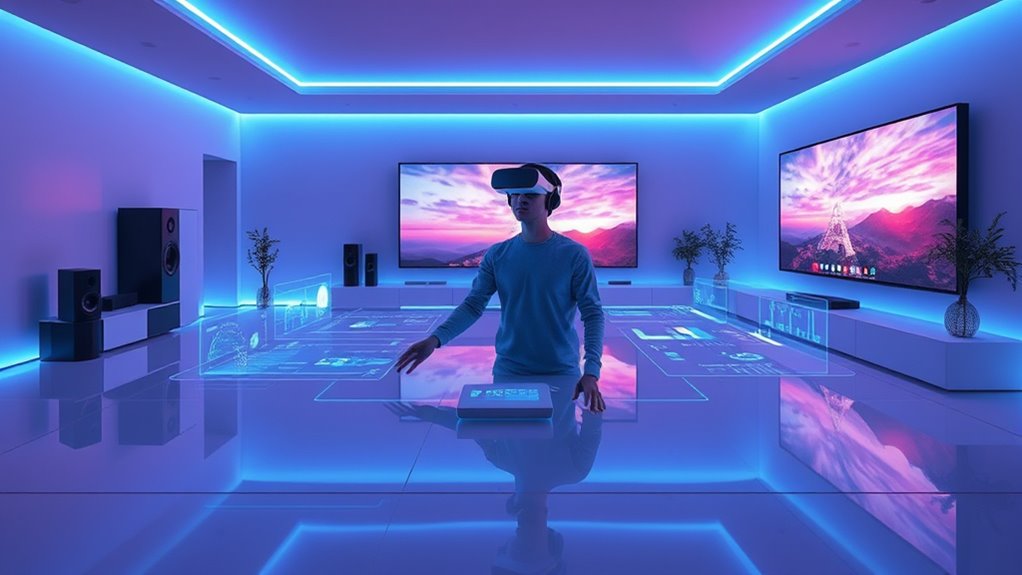
Immersive audio-visual interactivity is revolutionizing how you connect and experience digital content within smart homes. Advanced high-realism video conferencing, augmented reality, and holograms enable seamless virtual communication that feels incredibly lifelike.
You can enjoy immersive experiences with personalized, multi-sensory environments tailored to your preferences. Connectivity stability is prioritized, ensuring real-time engagement for remote work, virtual events, and interactive media without buffering delays.
AI-driven content anticipation enhances your media experience by offering automatic recommendations and customized viewing. Enhanced audio-visual interactivity allows you to intuitively control and interact with virtual elements, making remote communication more engaging and lifelike.
These innovations transform the way you socialize, entertain, and collaborate within your smart home environment.
- Real-time holographic calls
- Personalized multi-sensory environments
- AI-driven content suggestions
- Seamless augmented reality integration
- Intuitive virtual interaction controls
Innovative Devices and Personalized Living Environments
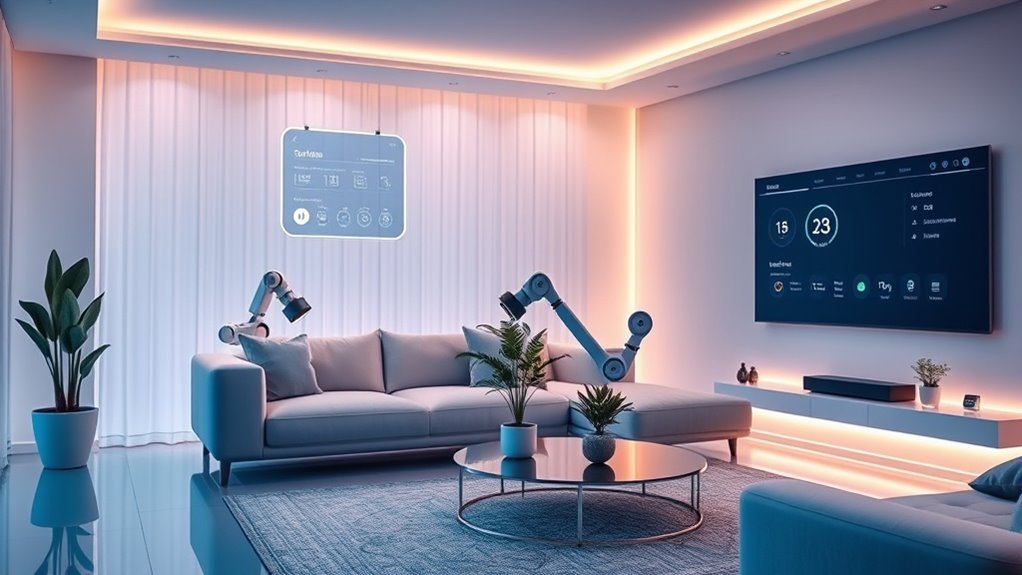
With the rise of innovative devices, your smart home becomes more personalized and adaptable than ever before. Wearable tech will expand beyond health monitoring to include home management data, giving you insights to automatically adjust lighting, temperature, and security.
Connected devices will create a seamless ecosystem, allowing you to customize your environment precisely to your preferences. Increased adoption of wearable tech enables real-time sharing of environmental and health data, so your home can automatically optimize for comfort and wellness.
AI-driven automation anticipates your routines, preparing spaces and devices before you even ask. As these innovative devices become more accessible, fully personalized, smarter homes will blend advanced technology effortlessly into your daily life, making your living space uniquely tailored to your needs.
Sustainable Technologies and Energy-Efficient Smart Homes
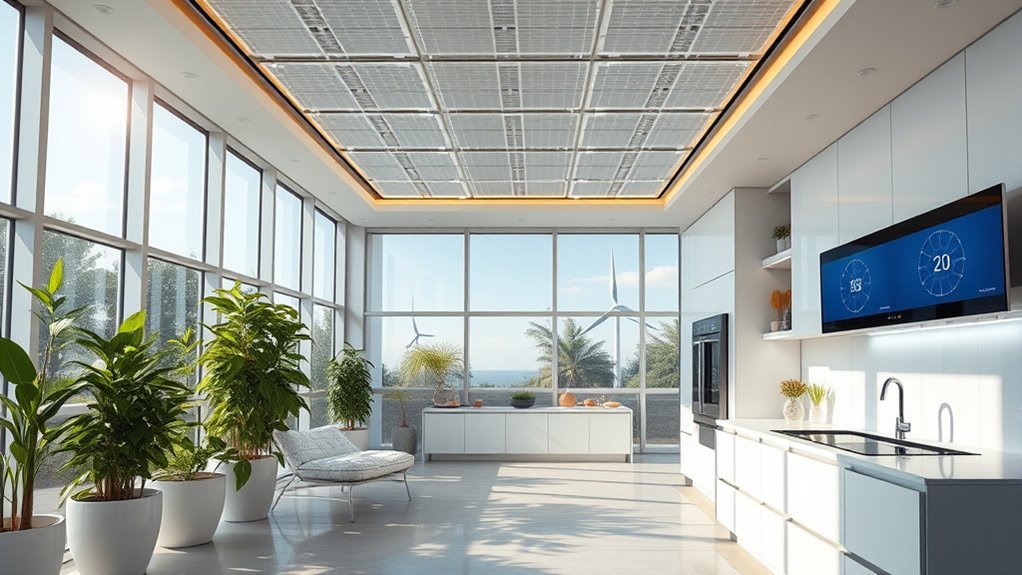
As smart home technology advances, energy efficiency becomes a central focus, helping you reduce waste and lower utility bills. Future smart homes will automatically optimize energy consumption with real-time adjustments, making your home more sustainable.
Zero-energy homes, powered by renewable sources like solar panels and advanced energy management systems, will be common. Smart systems will incorporate sustainable technologies to improve water conservation through smart irrigation, leak detection, and greywater recycling.
Building design will prioritize eco-friendly materials and construction practices to minimize environmental impact. To maximize sustainability, expect:
- Automated energy management systems
- Integration of renewable energy sources
- Smart water conservation solutions
- Eco-friendly building materials
- Energy-efficient appliances supporting climate goals
These innovations will markedly enhance your home’s sustainability, reducing costs and environmental footprint.
Robotics and Automation for Household Tasks and Care
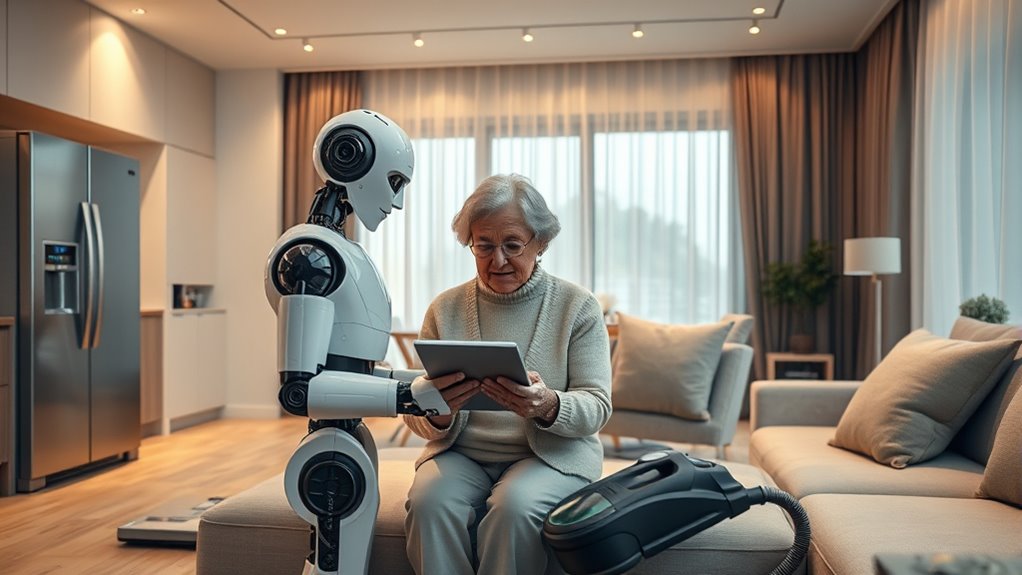
Robotics and automation are transforming household tasks and personal care by offering intelligent, efficient solutions that reduce your daily workload. With advanced home automation, robotics like autonomous vacuums and robotic arms now perform chores with high precision and multi-surface recognition.
Future home robots will use AI and sensors to identify objects, avoid obstacles, and handle complex tasks such as restocking groceries or preparing meals. Health-monitoring robots, including sensor-equipped toilets, will track essential signs and detect early disease indicators, enabling proactive healthcare right at home.
Additionally, AI-powered assistive robots and home gyms will personalize care for elderly or disabled residents. Domestic surveillance drones could also enhance security, providing continuous coverage beyond traditional camera systems, making your home safer and more autonomous.
Health Monitoring Systems and Wellness-Focused Features

Smart homes are increasingly integrating health monitoring systems and wellness-focused features that empower you to take control of your well-being. With smart home technology, your environment becomes a health hub, offering personalized insights and early detection.
Imagine smart furniture like mattresses and chairs that track sleep quality, posture, and essential signs to optimize your health. AI-powered home gyms provide tailored workout routines with real-time feedback and immersive virtual reality experiences.
Diagnostic devices, such as smart mirrors and toilets, conduct daily health assessments and identify early signs of illness. Homes will serve as centralized wellness hubs, seamlessly blending fitness, health monitoring, and preventive care.
These innovations enable early health anomaly detection, supporting proactive healthcare and enhancing your overall well-being.
- Sleep quality monitoring
- Posture and vital sign tracking
- Virtual reality fitness
- Daily health assessments
- Preventive care integration
Future Trends in Data Privacy, Ownership, and User Control
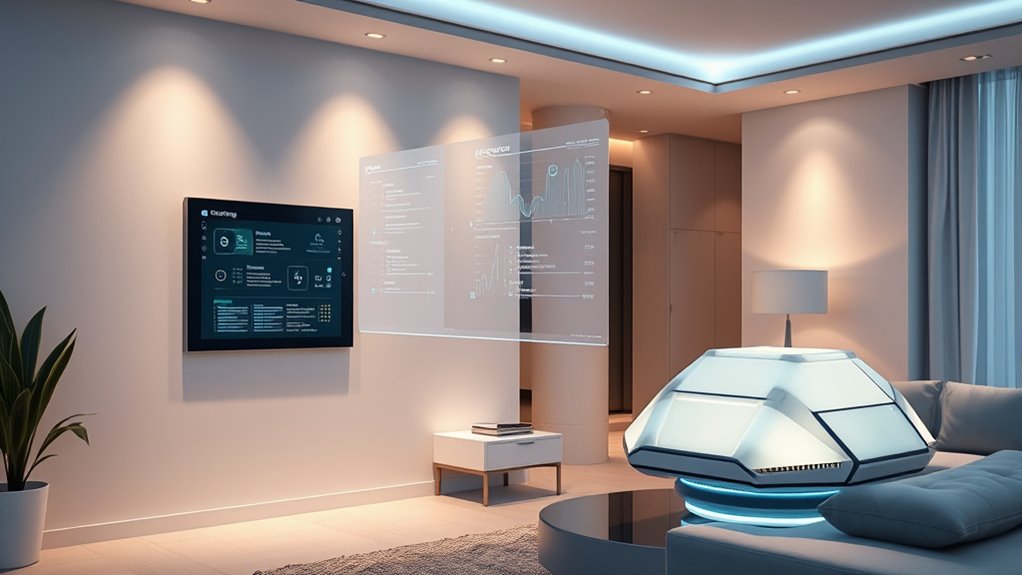
The future of data privacy in smart homes is set to transform how you control and protect your personal information. Expect increased control over data ownership, with markets allowing you to sell or share your home-generated data securely. Privacy regulations will become clearer, ensuring transparent data handling and giving you options to opt out. Advances in AI will process data locally on devices, reducing reliance on cloud storage and boosting your privacy. Decentralized data architectures will give you more autonomy over who accesses your information. Additionally, secure, encrypted systems will become standard, preventing unauthorized access and reinforcing user control.
| Trend | Impact | Key Feature |
|---|---|---|
| Increased data ownership | Sell/share data securely | User autonomy |
| Evolving privacy regulations | Clear consent and opt-out | Transparency |
| Local data processing | Enhanced privacy | Reduced cloud reliance |
| Decentralized architectures | Greater user control | Data autonomy |
| Secure encryption systems | Prevent unauthorized access | Data security |
Frequently Asked Questions
What Is the Future of Smart Homes?
You’re wondering about the future of smart homes. It’s exciting to know that AI will become fully integrated, learning your routines and adjusting everything automatically.
Connectivity will be seamless, so your devices respond instantly. Security will be smarter with biometric scans and AI surveillance, while personalized settings will adapt to your preferences through wearable devices.
Automation won’t just be manual anymore; it’ll be dynamic, continuously optimizing comfort, safety, and energy efficiency for you.
What Are the Projections for Smart Home?
Imagine walking into your home where everything responds seamlessly—the lights adjust, your favorite music plays, and your security system is alert.
The projections for smart homes show rapid growth, reaching over $1 trillion by 2031. Connectivity will be lightning-fast, security more sophisticated, and personal comfort tailored precisely to you.
With a 23.60% CAGR, smart homes will become more intuitive, secure, and energy-efficient, transforming your everyday living experience.
What Is the Future of Smart Technology?
You’ll see smart technology becoming more intuitive and personalized. Devices will anticipate your needs, adjusting settings automatically through AI and wearable links.
Security will rely on biometric recognition, making passwords obsolete. Expect immersive AR and holographic interfaces for entertainment and communication.
Energy use will be optimized with AI, creating zero-energy homes powered by renewables. Overall, smart tech will seamlessly integrate into your daily life, enhancing convenience, security, and sustainability.
What’s Next in Home Automation?
You’re wondering what’s next in home automation, and the answer’s exciting. Automation will become smarter, more intuitive, and more personalized.
You’ll see devices that anticipate your needs, adjust settings automatically, and communicate seamlessly thanks to faster connectivity.
Biometric and behavioral recognition will tailor experiences just for you.
With intuitive interfaces, controlling your smart home will feel natural and effortless, making everyday living easier, more comfortable, and more connected than ever before.
Conclusion
As you embrace these smart home innovations, it’s natural to worry about privacy and control. Rest assured, future systems will prioritize your data security with advanced encryption and user-centric controls. By staying informed and choosing devices that emphasize transparency, you’ll enjoy seamless convenience without sacrificing your privacy. The smart home of tomorrow offers personalized comfort and safety, empowering you to live more efficiently—without compromising your peace of mind.



